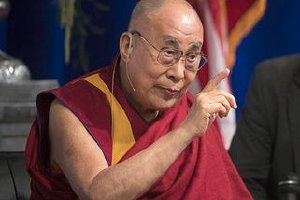Marc Lieberman, a San Francisco ophthalmologist who organized dialogue between the Dalai Lama and American Jewish leaders and restored the eyesight of thousands of Tibetans, died August 2 at 72. Lieberman leaves behind a legacy that combined faith, drive and compassion.

Combining Buddhist practices and principles with Judaism, Lieberman kept kosher, studied the Torah, and observed the Sabbath, but he also meditated several times a day and helped build a Buddhist monastery in Northern California. “I’m a healthy mosaic of Judaism and Buddhism,” Lieberman said in an interview with The Los Angeles Times in 2006.
When the Dalai Lama visited the U.S. in 1989, Congressman Tom Lantos of California asked Lieberman, a personal friend, if he would facilitate a dialogue between the Tibetan spiritual leader and American Jewish religious leaders.
Lieberman arranged what he referred to as a “dream team” of rabbis and Jewish scholars for a one-day meeting with the Dalai Lama at a Buddhist temple in New Jersey.
The Dalai Lama was impressed by the brief but extraordinary cross-cultural encounter. But Lieberman wanted to extend it further. He arranged a second meeting and accompanied eight of the Jewish leaders to Dharamshala, the Himalayan city in India where the Dalai Lama has lived in exile since China occupied Tibet in 1959.
Once again, the rabbis and Jewish scholars engaged the Dalai Lama and Buddhist colleagues in discussion about their respective faiths. This time the dialogue lasted four days, covering such spiritual issues as human suffering, the concept of God in the two religions, and the role of mysticism in each of them.
It was during these conversations that Lieberman learned from the Dalai Lama and his staff of the fate tens of thousands of Tibetans in their homeland suffer. Living 15,000 feet above sea level on the “Roof of the World,” they suffer the effects of intense ultraviolet radiation that floods the Tibetan Plateau. As many as 15 percent of Tibetans 40 and older and 50 percent of those over 70 suffer from cataracts, a medical condition that can ultimately cause blindness if not treated.
Lieberman, founded the Tibet Vision Project, largely a one-man mission, and twice a year, occasionally accompanied by a colleague, Lieberman traveled to Tibet, where he conducted and supervised cataract surgery. The Dalai Lama praised his work as “a great act of kindness.”
By 2005, Lieberman had trained 20 Tibetan surgeons with whose help he restored the eyesight of more than 2,000 people. Many of them traveled for days to sign up for Lieberman’s eye camp. His remarkable work is captured in an award-winning 2006 documentary film, Visioning Tibet. Today, some 5,000 Tibetans have regained their sight thanks to his work
“It’s a profound irony Tibetans are blind in this majestic land,” Lieberman once said. “They are blinded by the light that so delights us.”
“I remember him saying to the Dalai Lama, ‘When you come back to Tibet, I want the Tibetan people to see you,’” recalled Rodger Kamenetz, a poet and lifelong friend who accompanied Lieberman on his visit with the Dalai Lama.
Kamenetz was so moved by the 1990 trip that following a personal crisis in his own life, he wrote about the Himalayan encounter between Buddhism and Judaism in his 1994 book, The Jew in the Lotus: A Poet’s Rediscovery of Jewish Identity in Buddhist India.
The book, which a review in The New York Times recommended to “anyone who feels the narrowness of a wholly secular life,” became a bestseller that led thousands of Americans to explore Buddhism, while compelling others to discover the mystical aspects of Judaism.
“Marc really deserves credit for that dialogue,” Kamenetz told The New York Times, “for opening Jews to their own meditative and esoteric traditions.”
Shortly before Lieberman died, Kamenetz accompanied him to a chemotherapy appointment in San Francisco. “We were really enjoying the flowering trees … just taking in each flower, each tree,” Kamenetz recalled. “Naturally we were talking about impermanence.”
“And he said the most beautiful thing: that impermanence doesn’t just mean that everything goes away, but also that there’s always something new coming into focus.”
That, in fact, must have been how those thousands of Tibetans felt after a Good Samaritan from 7,300 miles away restored their vision.
______________
The Church of Scientology publishes this blog to help create a better understanding of the freedom of religion and belief and provide news on religious freedom and issues affecting this freedom around the world.
The Founder of the Scientology religion is L. Ron Hubbard and Mr. David Miscavige is the religion’s ecclesiastical leader.
For more information, visit the Scientology website or the Scientology TV network.


